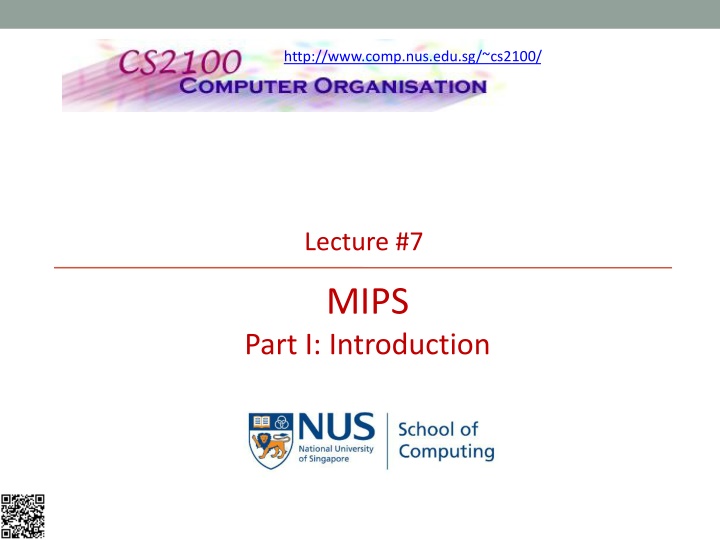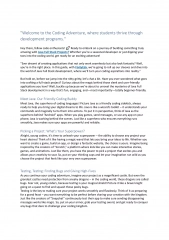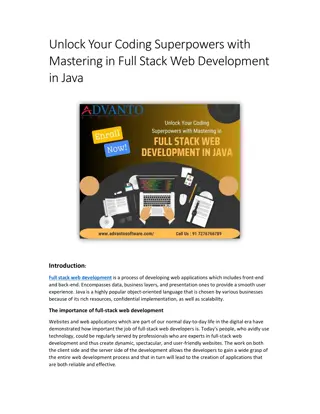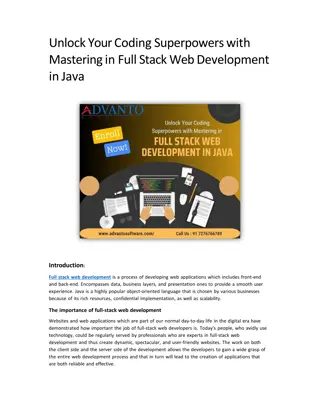
MIPS Part I Introduction: Instruction Set Architecture and Assembly Language
Explore the fundamentals of MIPS Part I Introduction, covering Instruction Set Architecture, Machine Code vs Assembly Language, General Purpose Registers, MIPS Assembly Language syntax, and logical operations. Understand how compilers and assemblers translate high-level programming languages to machine language instructions. Learn about the importance of Instruction Set Architecture in bridging hardware and software interactions.
Download Presentation

Please find below an Image/Link to download the presentation.
The content on the website is provided AS IS for your information and personal use only. It may not be sold, licensed, or shared on other websites without obtaining consent from the author. If you encounter any issues during the download, it is possible that the publisher has removed the file from their server.
You are allowed to download the files provided on this website for personal or commercial use, subject to the condition that they are used lawfully. All files are the property of their respective owners.
The content on the website is provided AS IS for your information and personal use only. It may not be sold, licensed, or shared on other websites without obtaining consent from the author.
E N D
Presentation Transcript
http://www.comp.nus.edu.sg/~cs2100/ Lecture #7 MIPS Part I: Introduction
Questions? Ask at https://sets.netlify.app/module/676ca3a07d7f5ffc1741dc65 OR Scan and ask your questions here! (May be obscured in some slides)
Aaron Tan, NUS Lecture #7: MIPS Part 1: Introduction 3 Lecture #7: MIPS Part 1: Introduction (1/2) 1. Instruction Set Architecture 2. Machine Code vs Assembly Language 3. Walkthrough 4. General Purpose Registers 5. MIPS Assembly Language 5.1 General Instruction Syntax 5.2 Arithmetic Operation: Addition 5.3 Arithmetic Operation: Subtraction 5.4 Complex Expression 5.5 Constant/Immediate Operands 5.6 Register Zero ($0 or $zero)
Aaron Tan, NUS Lecture #7: MIPS Part 1: Introduction 4 Lecture #7: MIPS Part 1: Introduction (1/2) 5. MIPS Assembly Language 5.7 Logical Operations: Overview 5.8 Logical Operations: Shifting 5.9 Logical Operations: Bitwise AND 5.10 Logical Operations: Bitwise OR 5.11 Logical Operations: Bitwise NOR 5.12 Logical Operations: Bitwise XOR 6. Large Constant: Case Study 7. MIPS Basic Instructions Checklist
Aaron Tan, NUS Lecture #7: MIPS Part 1: Introduction 5 Recap You write programs in high-level programming languages, e.g., C/C++, Java: A + B Compiler translates this into assembly language statement: add A, B Assembler translates this statement into machine language instructions that the processor can execute: 1000 1100 1010 0000
Aaron Tan, NUS Lecture #7: MIPS Part 1: Introduction 6 1. Instruction Set Architecture (1/2) Instruction Set Architecture (ISA): An abstraction on the interface between the hardware and the low-level software. Software (to be translated to the instruction set) Instruction Set Architecture Hardware (implementing the instruction set)
Aaron Tan, NUS Lecture #7: MIPS Part 1: Introduction 7 1. Instruction Set Architecture (2/2) Instruction Set Architecture Includes everything programmers need to know to make the machine code work correctly Allows computer designers to talk about functions independently from the hardware that performs them This abstraction allows many implementations of varying cost and performance to run identical software. Example: Intel x86/IA-32 ISA has been implemented by a range of processors starting from 80386 (1985) to Pentium 4 (2005) Other companies such as AMD and Transmeta have implemented IA-32 ISA as well A program compiled for IA-32 ISA can be executed on any of these implementations
Aaron Tan, NUS Lecture #7: MIPS Part 1: Introduction 8 2. Machine Code vs Assembly Language Machine Code Instructions in binary e.g.: 1000 1100 1010 0000 Add two numbers Hard and tedious to code Assembly Language Human readable e.g.: add A, B Add two numbers Easier to write than machine code, symbolic version of machine code 1000 1100 1010 0000 ASSEMBLER add A, B May also be written in hexadecimal for a more human-readable format May provide pseudo-instructions as syntactic sugar When considering performance, only real instructions are counted NOTE: Syntactic "sugar" is basically a translation scheme from a language to the same language (e.g., from C to C or in this case from MIPS to MIPS). The pseudo-instructions are then translated into one or more real instructions. For example, in MIPS, we have move $rd, $rs being translated into add $rd, $rs, $zero.
Aaron Tan, NUS Lecture #7: MIPS Part 1: Introduction 9 3. Walkthrough: An Example Code (1/15) Let us take a journey with the execution of a simple code: Discover the components in a typical computer Learn the type of instructions required to control the processor Simplified to highlight the important concepts // assume res is 0 initially for (i=1; i<10; i++) { res = res + i; } res i i + 1 if i < 10, repeat res + i compile to C-like code fragment Assembly Code NOTE: Not a real "assembly" language but hopefully instructive enough for our purpose.
Aaron Tan, NUS Lecture #7: MIPS Part 1: Introduction 10 3. Walkthrough: The Components (2/15) The two major components in a computer Processor and Memory Input/Output devices omitted in this example Memory Processor Bus Perform computations Bridge between the two components Storage of code and data NOTE: "Bus" is really just a data connector between memory and processor. Memory is typically simply a RAM.
Aaron Tan, NUS Lecture #7: MIPS Part 1: Introduction 11 3. Walkthrough: The Code in Action (3/15) The code and data reside in memory Transferred into the processor during execution Memory Processor .. res res + i Inst res res + i Bus i i + 1 if i < 10, res+i ALU 1 i 0 res ..
Aaron Tan, NUS Lecture #7: MIPS Part 1: Introduction 12 3. Walkthrough: Memory Access is Slow! (4/15) To avoid frequent access of memory Provide temporary storage for values in the processor (known as registers) Memory Processor .. res res + i Inst Bus i i + 1 r0 r1 .. if i < 10, ALU 1 i 0 res ..
Aaron Tan, NUS Lecture #7: MIPS Part 1: Introduction 13 3. Walkthrough: Memory Instruction (5/15) Need instruction to move data into registers Also to move data from registers to memory later Memory .. r0 load i r1 load res Processor r0 load i Inst Bus res res + i i i + 1 1 r0 r1 .. if i < 10, ALU 1 i 0 res Moving data from memory into a register load Moving data from a register into memory store ..
Aaron Tan, NUS Lecture #7: MIPS Part 1: Introduction 14 3. Walkthrough: Memory Instruction (6/15) Need instruction to move data into registers Also to move data from registers to memory later Memory .. r0 load i r1 load res Processor r1 load res Inst Bus res res + i i i + 1 1 0 r0 r1 .. if i < 10, ALU 1 i 0 res Moving data from memory into a register load Moving data from a register into memory store ..
Aaron Tan, NUS Lecture #7: MIPS Part 1: Introduction 15 3. Walkthrough: Reg-to-Reg Arithmetic (7/15) Arithmetic operations can now work directly on registers only (much faster!) Memory .. r0 load i r1 load res Processor r1 r1 + r0 Inst Bus r1 r1 + r0 r0 r0 + 1 1 0 1 r0 r1 .. if r0 < 10, ALU 1 i 0 res ..
Aaron Tan, NUS Lecture #7: MIPS Part 1: Introduction 16 3. Walkthrough: Reg-to-Reg Arithmetic (8/15) Sometimes, arithmetic operation uses a constant value instead of register value Memory .. r0 load i r1 load res Processor r0 r0 + 1 Inst Bus r1 r1 + r0 r0 r0 + 1 2 1 1 r0 r1 .. if r0 < 10, ALU 1 1 i 0 res ..
Aaron Tan, NUS Lecture #7: MIPS Part 1: Introduction 17 3. Walkthrough: Execution Sequence (9/15) Instruction is executed sequentially by default How do we repeat or make a choice ? Memory .. r0 load i r1 load res Processor Inst Bus r1 r1 + r0 r0 r0 + 1 r0 r1 .. if r0 < 10, ALU 1 i 0 res ..
Aaron Tan, NUS Lecture #7: MIPS Part 1: Introduction 18 3. Walkthrough: Control Flow (10/15) We need instructions to change the control flow based on condition: Repetition (loop) and Selection (if-else) can both be supported Memory .. r0 load i r1 load res Processor Inst if r0 < 10, repeat Bus r1 r1 + r0 r0 r0 + 1 2 r0 r1 .. if r0 < 10, ALU 1 1 i 0 res ..
Aaron Tan, NUS Lecture #7: MIPS Part 1: Introduction 19 3. Walkthrough: Looping! (11/15) Since the condition succeeded, execution will repeat from the indicated position Memory .. r0 load i r1 load res Processor Inst r1 r1 + r0 Bus r1 r1 + r0 r0 r0 + 1 2 r0 r1 .. if r0 < 10, ALU 1 3 1 i 0 res ..
Aaron Tan, NUS Lecture #7: MIPS Part 1: Introduction 20 3. Walkthrough: Looping! (12/15) Execution will continue sequentially Until we see another control flow instruction Memory .. r0 load i r1 load res Processor Inst r0 r0 + 1 Bus r1 r1 + r0 r0 r0 + 1 2 3 r0 r1 .. if r0 < 10, ALU 3 1 1 i 0 res ..
Aaron Tan, NUS Lecture #7: MIPS Part 1: Introduction 21 3. Walkthrough: Looping! (13/15) The three instructions will be repeated until the condition fails Memory .. r0 load i r1 load res Processor Inst if r0 < 10, repeat Bus r1 r1 + r0 r0 r0 + 1 10 r0 r1 .. if r0 < 10, ALU 45 1 i 0 res ..
Aaron Tan, NUS Lecture #7: MIPS Part 1: Introduction 22 3. Walkthrough: Memory Instruction (14/15) We can now move back the values from register to their home in memory Similarly for r1 to res Memory .. r0 load i r1 load res Processor i store r0 Inst Bus r1 r1 + r0 r0 r0 + 1 10 r0 r1 .. if r0 < 10, i store r0 ALU 45 1 10 i 0 res ..
Aaron Tan, NUS Lecture #7: MIPS Part 1: Introduction 23 3. Walkthrough: Summary (15/15) The stored-memory concept: Both instruction and data are stored in memory The load-store model: Limit memory operations and relies on registers for storage during execution The major types of assembly instruction: Memory: Move values between memory and registers Calculation: Arithmetic and other operations Control flow: Change the sequential execution NOTE: A typical assembly code structure is: (1) load, (2) compute, (3) store. We will assume in this module that we have enough register to store all variables in our program.
Aaron Tan, NUS Lecture #7: MIPS Part 1: Introduction 24 4. General Purpose Registers (1/2) Fast memories in the processor: Data are transferred from memory to registers for faster processing Limited in number: A typical architecture has 16 to 32 registers Compiler associates variables in program with registers Registers have no data type Unlike program variables! Machine/Assembly instruction assumes the data stored in the register is of the correct type
Aaron Tan, NUS Lecture #7: MIPS Part 1: Introduction 25 4. General Purpose Registers (2/2) There are 32 registers in MIPS assembly language: Can be referred by a number ($0, $1, , $31) OR Referred by a name (eg: $a0, $t1) Register number 0 Register number Name Usage Name Usage Constant value 0 Values for results and expression evaluation Arguments Temporaries Program variables More temporaries Global pointer Stack pointer Frame pointer Return address $zero 24-25 $t8-$t9 2-3 28 29 30 31 $v0-$v1 $gp $sp 4-7 8-15 16-23 $a0-$a3 $fp $t0-$t7 $ra $s0-$s7 $at (register 1) is reserved for the assembler. $k0-$k1 (registers 26-27) are reserved for the operating system.
Aaron Tan, NUS Lecture #7: MIPS Part 1: Introduction 26 5. MIPS Assembly Language Each instruction executes a simple command Usually has a counterpart in high-level programming languages like C/C++, Java etc Each line of assembly code contains at most 1 instruction # (hex-sign) is used for comments Anything from # to end of line is a comment and will be ignored by the assembler add $t0, $s1, $s2 # $t0 $s1 + $s2 sub $s0, $t0, $s3 # $s0 $t0 - $s3
Aaron Tan, NUS Lecture #7: MIPS Part 1: Introduction 27 5.1 General Instruction Syntax add $s0, $s1, $s2 Source 2 Operation (op) Source 1 Destination (gets the result) $s0 = $s1 + $s2 Naturally, most of the MIPS arithmetic/logic operations have three operands: 2 sources and 1 destination
Aaron Tan, NUS Lecture #7: MIPS Part 1: Introduction 28 5.2 Arithmetic Operation: Addition C Statement MIPS Assembly Code add $s0, $s1, $s2 a = b + c; We assume the values of "a", "b" and "c" are loaded into registers "$s0", "$s1" and "$s2" Known as variable mapping Actual code to perform the loading will be shown later in memory instruction Important concept: MIPS arithmetic operations are mainly register-to-register NOTE: The variable-to-register mapping deals with step (1) (i.e., load) and step (3) (i.e., store). All computations are assumed to be in register for this set of instructions. We will talk about load/store in the next lecture.
Aaron Tan, NUS Lecture #7: MIPS Part 1: Introduction 29 5.3 Arithmetic Operation: Subtraction C Statement a = b - c; MIPS Assembly Code sub $s0, $s1, $s2 $s0 variable a $s1 variable b $s2 variable c Positions of $s1 and $s2 (i.e., source1 and source2) are important for subtraction NOTE: sub $s0, $s1, $s2 is basically $s0 = $s1 - $s2
Aaron Tan, NUS Lecture #7: MIPS Part 1: Introduction 30 5.4 Complex Expression (1/3) C Statement a = b + c - d; MIPS Assembly Code ??? ??? ??? $s0 variable a $s1 variable b $s2 variable c $s3 variable d t0 = b + c; a = t0 - d; A single MIPS instruction can handle at most two source operands Need to break a complex statement into multiple MIPS instructions MIPS Assembly Code add $t0, $s1, $s2 # tmp = b + c sub $s0, $t0, $s3 # a = tmp - d Use temporary registers $t0 to $t7 for intermediate results
Aaron Tan, NUS Lecture #7: MIPS Part 1: Introduction 31 5.4 Complex Expression: Example (2/3) C Statement Variable Mappings $s0 variable f $s1 variable g $s2 variable h $s3 variable i $s4 variable j f = (g + h) (i + j); t0 = g + h; t1 = i + j; f = t0 t1; Break it up into multiple instructions Use two temporary registers $t0, $t1 add $t0, $s1, $s2 # tmp0 = g + h add $t1, $s3, $s4 # tmp1 = i + j sub $s0, $t0, $t1 # f = tmp0 tmp1
Aaron Tan, NUS Lecture #7: MIPS Part 1: Introduction 32 5.4 Complex Expression: Exercise (3/3) C Statement Variable Mappings $s0 variable a $s1 variable b $s2 variable c $s3 variable d $s4 variable z z = a + b; z = z + c; z = z + d; z = a + b + c + d; add $s4, $s0, $s1 add $s4, $s4, $s2 add $s4, $s4, $s3 C Statement Variable Mappings $s0 variable a $s1 variable b $s2 variable c $s3 variable z z = a - b; z = z + c; z = (a b) + c; sub $s3, $s0, $s1 add $s3, $s3, $s2
Aaron Tan, NUS Lecture #7: MIPS Part 1: Introduction 33 5.5 Constant/Immediate Operands C Statement MIPS Assembly Code a = a + 4; addi $s0, $s0, 4 Immediate values are numerical constants Frequently used in operations MIPS supplies a set of operations specially for them Add immediate (addi) Syntax is similar to add instruction; but source2 is a constant instead of register The constant ranges from [-215 to 215-1] There s no subi. Why? Can you guess what number system is used? Answer: Use addiwith negative constant Answer: 16-bit 2s complement number system
Aaron Tan, NUS Lecture #7: MIPS Part 1: Introduction 34 5.6 Register Zero ($0 or $zero) The number zero (0), appears very often in code Provide register zero ($0 or $zero) which always have the value 0 C Statement MIPS Assembly Code add $s0, $s1, $zero f = g; $s0 variable f $s1 variable g f = g + 0 The above assignment is so common that MIPS has an equivalent pseudo-instruction (move): Pseudo-Instruction "Fake" instruction that gets translated to corresponding MIPS instruction(s). Provided for convenience in coding only. MIPS Assembly Code move $s0, $s1
Aaron Tan, NUS Lecture #7: MIPS Part 1: Introduction 35 5.7 Logical Operations: Overview (1/2) Arithmetic instructions view the content of a register as a single quantity (signed or unsigned integer) New perspective: View register as 32 raw bits rather than as a single 32-bit number Possible to operate on individual bits or bytes within a word Logical operation Shift Left Shift right Bitwise AND Bitwise OR Bitwise NOT* Bitwise XOR C operator Java operator << >>, >>> & | ~ ^ MIPS instruction sll srl and, andi or, ori nor xor << >>** & | ~ ^ *with some tricks **this is "arithmetic" shift in both GCC and Clang (compiler dependent)
Aaron Tan, NUS Lecture #7: MIPS Part 1: Introduction 36 5.7 Logical Operations: Overview (2/2) Truth tables of logical operations 0 represents false; 1 represents true AND OR a 0 0 1 1 b 0 1 0 1 a AND b 0 0 0 1 a 0 0 1 1 b 0 1 0 1 a OR b 0 1 1 1 NOTE: 1 if BOTH a and b are 1. Otherwise 0. NOTE: 0 if BOTH a and b are 0. Otherwise 1. NOR XOR a 0 0 1 1 b 0 1 0 1 a NOR b 1 0 0 0 a 0 0 1 1 b 0 1 0 1 a XOR b 0 1 1 0 NOTE: 1 if BOTH a and b are 1. Otherwise 0. NOTE: 1 if a is NOT same as b. the
Aaron Tan, NUS Lecture #7: MIPS Part 1: Introduction 37 5.8 Logical Operations: Shifting (1/2) Opcode: sll (shift left logical) Move all the bits in a word to the left by a number of positions; fill the emptied positions with zeroes. E.g. Shift bits in $s0 to the left by 4 positions $s0 1011 1000 0000 0000 0000 0000 0000 1001 sll $t2, $s0, 4 # $t2 = $s0<<4 $t2 1000 0000 0000 0000 0000 0000 1001 0000 NOTE: The emptied positions are filled with 0s
Aaron Tan, NUS Lecture #7: MIPS Part 1: Introduction 38 5.8 Logical Operations: Shifting (2/2) Opcode: srl (shift right logical) Shifts right and fills emptied positions with zeroes. What is the equivalent math operations for shifting left/right n bits? Answer: Shifting is faster than multiplication/division Good compiler translates such multiplication/division into shift instructions Multiply/divide by 2n C Statement a = a * 8; MIPS Assembly Code sll $s0, $s0, 3 NOTE: Since 8 = 23, we can use a = a << 3.
Aaron Tan, NUS Lecture #7: MIPS Part 1: Introduction 39 5.9 Logical Operations: Bitwise AND Opcode: and ( bitwise AND ) Bitwise operation that leaves a 1 only if both the bits of the operands are 1 E.g.: and$t0, $t1, $t2 $t1 $t2 0110 0011 0010 1111 0000 1101 0101 1001 0000 0000 0000 0000 0011 1100 0000 0000 mask 0000 0000 0000 0000 0000 1100 0000 0000 $t0 and can be used for masking operation: Place 0s into the positions to be ignored bits will turn into 0s Place 1s for interested positions bits will remain the same as the original. NOTE: Bit-mask is setting the irrelevant part to 0 (i.e., masked).
Aaron Tan, NUS Lecture #7: MIPS Part 1: Introduction 40 5.9 Exercise: Bitwise AND We are interested in the last 12 bits of the word in register $t1. Result to be stored in $t0. Q: What s the mask to use? $t1 mask 0000 1001 1100 0011 0101 1101 1001 1100 0000 0000 0000 0000 0000 1111 1111 1111 $t0 0000 0000 0000 0000 0000 1101 1001 1100 NOTE: Keep last 12-bits as 1. This is equivalent to andi $t1, $t1, 0xFFF. Notes: The and instruction has an immediate version, andi
Aaron Tan, NUS Lecture #7: MIPS Part 1: Introduction 41 5.10 Logical Operations: Bitwise OR Opcode: or ( bitwise OR ) Bitwise operation that places a 1 in the result if either operand bit is 1 Example: or $t0, $t1, $t2 The or instruction has an immediate version ori Can be used to force certain bits to 1s E.g.: ori $t0, $t1, 0xFFF $t1 0000 1001 1100 0011 0101 1101 1001 1100 0000 0000 0000 0000 0000 1111 1111 1111 0xFFF 0000 1001 1100 0011 0101 1111 1111 1111 $t0 For ori $t0, $t1, 0xFFFF will the upper 16-bits be all 0s or all 1s? Answer: all 0s (in other words, this is not sign-extended)
Aaron Tan, NUS Lecture #7: MIPS Part 1: Introduction 42 5.11 Logical Operations: Bitwise NOR Strange fact 1: There is no NOT instruction in MIPS to toggle the bits (1 0, 0 1) However, a NOR instruction is provided: Opcode: nor ( bitwise NOR ) a 0 0 1 1 b 0 1 0 1 a NOR b 1 0 0 0 Example: nor $t0, $t1, $t2 Question: How do we get a NOT operation? nor $t0, $t0, $zero Question: Why do you think is the reason for not providing a NOT instruction? One of design principles: Keep the instruction set small.
Aaron Tan, NUS Lecture #7: MIPS Part 1: Introduction 43 5.12 Logical Operations: Bitwise XOR Opcode: xor ( bitwise XOR ) Example: xor $t0, $t1, $t2 Question: Can we also get NOT operation from XOR? Yes, let $t2 contain all 1s. xor $t0, $t0, $t2 a 0 0 1 1 b 0 1 0 1 a XOR b 0 1 1 0 Strange Fact 2: There is no NORI, but there is XORI in MIPS Why? NOTE: A possible reason is that there is not much need for NORI. So there is no reason to add this capability to keep the processor design simple.
Aaron Tan, NUS Lecture #7: MIPS Part 1: Introduction 44 6. Large Constant: Case Study Question: How to load a 32-bit constant into a register? e.g10101010 10101010 11110000 11110000 1. Use load upper immediate (lui) to set the upper 16-bit: lui$t0, 0xAAAA #1010101010101010 Lower-order bits filled with zeros. 1010101010101010 0000000000000000 2. Use or immediate (ori) to set the lower-order bits: ori$t0, $t0, 0xF0F0 #1111000011110000 Higher-order bits filled with zeros. 1010101010101010 0000000000000000 0000000000000000 1111000011110000 ori 1010101010101010 1111000011110000
Aaron Tan, NUS Lecture #7: MIPS Part 1: Introduction 45 7. MIPS Basic Instructions Checklist Operation Opcode in MIPS Meaning add $rd, $rs, $rt addi$rt, $rs, C162s sub $rd, $rs, $rt sll $rd, $rt, C5 srl $rd, $rt, C5 and $rd, $rs, $rt andi $rt, $rs, C16 or $rd, $rs, $rt ori $rt, $rs, C16 nor $rd, $rs, $rt $rd = $rs + $rt $rt = $rs + C162s $rd = $rs - $rt $rd = $rt << C5 $rd = $rt >> C5 $rd = $rs & $rt $rt = $rs & C16 $rd = $rs | $rt $rt = $rs | C16 $rd = $rs $rt Addition Subtraction Shift left logical Shift right logical AND bitwise OR bitwise NOR bitwise xor $rd, $rs, $rt $rd = $rs ^ $rt XOR bitwise xori $rt, $rs, C16 $rt = $rs ^ C16 C5 is [0 to 25-1] C162sis[-215 to 215-1] C16isa 16-bit pattern
Aaron Tan, NUS Lecture #7: MIPS Part 1: Introduction 46 Additional Notes sll and srl only need 5 bits (i.e., C5) because shifting by 32-bits empties the register (i.e., set to 0). C16 are NOT sign-extended. A possible reason is because it is used for logical operations which typically concern with the bits as it is (plus, it is treated as raw bits and not number). C162s are sign-extended. Otherwise, addi will not work properly as the processor can only work with 32-bits.
Aaron Tan, NUS Lecture #7: MIPS Part 1: Introduction 47 Additional Notes You may wonder why we learn C to learn MIPS. The reason is simply because in C, we control the memory. So, the C code match closely to the corresponding MIPS code. All other language are too far removed from the underlying memory structure to be useful UNLESS we are only using a subset of those language. But in C, we are forced to use these simpler subset. This will hopefully make more sense once you start "compiling" from C to MIPS on your own.
Aaron Tan, NUS Lecture #7: MIPS Part 1: Introduction 49 End of File






















